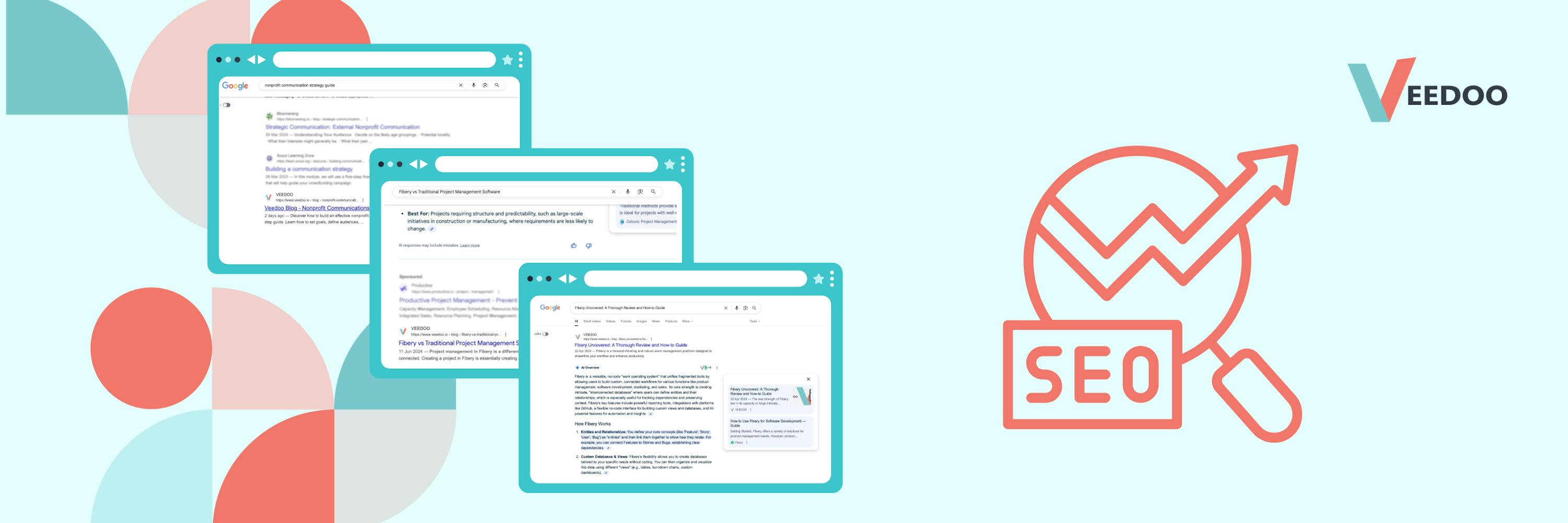Search in 2025 looks very different from just a few years ago. Every website is competing for two things: visibility in search results and a place in AI-generated overviews. Today, AI not only generates summaries but also rewrites titles and ranks results based on how well content matches user intent — rather than just keywords. That means headlines aren’t just about picking the right phrases anymore. They’re the difference between being seen or being skipped.
In this article, we’ll look at six practical ways to craft SEO titles that speak to both algorithms and real users, helping your content cut through the noise and earn trust.

Before we dive in, it’s important to separate two elements that often get confused: the SEO title tag and the H1 heading.
- The SEO title tag is the clickable blue link that appears in search engine results pages (SERPs) and the browser tab. It is designed to attract clicks by including target keywords and signalling value to users.
- The H1 tag is the main, visible heading on a webpage itself. It introduces the core topic of the page and helps both readers and search engines understand the content structure.
While they can be similar, the SEO title focuses on attracting clicks from search results, whereas the H1 is about guiding the reader once they land on the page.
Why headlines are the heart of SEO in 2025
For a long time, SEO was treated like a simple formula: ‘keyword at the beginning of the title = higher ranking in search results’. This approach is becoming increasingly less effective in 2025. The reason is simple: algorithms have learned to recognise the user's intent, not just a set of key phrases. Now, artificial intelligence creates search results, generates summaries, and even rewrites headlines on its own if they do not match what users are asking.
That's why an SEO title is now more than just a technical <title> tag. It can determine whether a user will even see your website and whether they will choose it among thousands of others.
A strong SEO title performs three key functions:
- It signals the content of the page to search algorithms.
- It forms the user's first impression in search results.
- It affects the click-through rate (CTR), which influences the site's longterm visibility.
When we ignore these functions, we lose clicks, traffic, and potential customers. Master them, and your titles become powerful drivers of SEO.
So how can you get it right? Let's look at six practical strategies for writing effective SEO titles — plus a bonus tip for success in the era of AI.
How to Write SEO Titles in 2025:
1. User = Priority.
Your title should be written so people immediately understand what value they will get from your page.
Examples:
"Buy iPhone 15 in Kyiv – Fast delivery"
– indicates location and speed, which is important for users who want to receive their goods quickly.
"How to choose a laptop? A beginner's guide (2025)"
– a common user question and the promise of a clear benefit (a beginner's guide).
"Tips for learning English from scratch"
– offers a clear solution to a specific problem.
"Order a website for your business from £5,000 – Fast and high quality"
– indicates price, speed, and quality — important factors for the customer.
Remember: If a user can’t tell what value they’ll get, they won’t click.
2. Meaning > Keyword
In 2025, algorithms recognise intent. That means stuffing a keyword into your title isn’t enough — your title has to make sense to people. Keywords should flow naturally, but benefits must come first.
For example:
❌ "Buy cheap trainers in Kyiv"
✅ "Trainers with 1-day delivery in Kyiv — free returns"
The second example combines the keyword (Kyiv trainers) with benefits users care about (speed, trust, flexibility).
Strong titles emphasise benefits, uniqueness, and solutions:
✅ Cut development time by 50% with our new tools
✅ Free webinar: How to increase your sales by 30%
✅ Learn to speak Polish in 3 months without stress
3. Build Trust Using the E-E-A-T Framework
In 2025, matching keywords isn’t enough — your titles also need to show that your content is reliable. That’s why Google relies on the E-E-A-T framework: Expertise, Experience, Authoritativeness, and Trustworthiness.
Your SEO titles can reinforce these signals:
- Expertise & Experience: Use precise, descriptive language that reflects real subject knowledge.
❌ “Tips for NGOs” – vague and generic
✅ “10 Fundraising Tips for NGOs in Ukraine from Local Experts” – specific, credible, and relevant
- Authoritativeness: Including a recognised brand or source in the title signals credibility.
✅ “CRM Solutions for Nonprofits | VEEDOO”
- Trustworthiness: Clear, benefit-oriented titles (e.g. highlighting free returns, security, guarantees) reassure both users and algorithms.
✅ “Trainers with 1-Day Delivery in Kyiv — Free Returns”
Takeaway: A strong SEO title is not just about visibility — it’s a trust signal that convinces both search engines and users your content deserves the click.
4. Add Brand Visibility to Your SEO Titles.
Including your brand name in SEO titles does more than add a label — it builds recognition, reinforces trust, and sets you apart from competitors.
Benefits of adding a brand to titles:
- Recognition in crowded SERPs: Repeated brand presence helps users remember and choose you.
- User-friendly navigation: With multiple tabs open, a brand mention makes it easy to spot your page.
- Signal of authority: Search engines favour consistent, credible brands — adding yours reinforces this.
- Competitive edge: In markets with many similar offers, a known brand can tip the scales in your favour.
Example:
- ❌ “Best CRM for Nonprofits”
- ✅ “Best CRM for Nonprofits | VEEDOO”
Takeaway: Adding your brand is a simple way to increase trust, strengthen recall, and stand out from competitors.
5. Structure the SEO Titles of All Pages for Clarity
Consistency matters. A logical title structure not only helps search engines understand your site but also makes navigation easier for users.
Example:
- Homepage: “VEEDOO – Websites, Software & Strategic Communication” (company + core services).
- Subpages follow the same pattern: "EU Projects | VEEDOO – EU Neighbours East”
This kind of hierarchy shows users what to expect and helps Google see how your content is organised. Avoid random or inconsistent formats — chaos in titles creates confusion for both people and algorithms.
6. Check How Titles Appear in Search Results
Even the best-written title can fail if it looks bad in the SERP. Always test how your SEO titles appear:
- Length: Is it truncated? (Keep under ~60 characters for desktop, ~50 for mobile.)
- Mobile view: Does it read clearly on smaller screens?
- Clarity: Is the main value obvious at a glance?
Examples of truncated titles:
- “How to write the perfect meta description: 7 steps to...”
- “Buy men’s trainers in Ukraine ➔ Online ...”
- “How not to break down in the first week? Rules for...”
What if Google rewrites your title?
Don’t panic — it’s common. Google adjusts titles to match specific queries. Sometimes this can even be useful, such as when your H1 appears instead of the title tag. But if your main target queries are consistently showing a rewritten version, that’s a signal to refine your SEO title.
Examples
Here we can see the SEO title in the search results:

Here we can see the headers in the search results:


Content formats search engines prefer:
In 2025, search engines favour content that is structured to answer user queries directly. When writing titles and content, consider these formats:
- Lists & comparisons → e.g. “7 CRM Tools Compared for NGOs”
- Question-based titles → “How, What, When, Where” are powerful entry points (“How to Choose the Right CMS in 2025”).
- Clear answers in the body → Headlines should promise value, and the content must deliver it.
Building these patterns into your titles and content improves both visibility in SERPs and the likelihood of being pulled into AI-generated summaries.
Bonus Tip 😎 — Use an llms.txt File
If you want AI systems to include your site in their overviews and explain it correctly, you’ll need an llms.txt file. Think of it as an SEO map designed specifically for large language models.
This file is different from robots.txt or sitemap.xml. It doesn’t tell search bots what to crawl — instead, it helps AI models quickly locate the most relevant content on your site so they can reference it in responses.
To learn how to set up llms.txt for your site, see Victoria’s guide: LLMS.txt Files Explained – and Why You Need One for AI Search
The Bottom Line
Optimising SEO titles in 2025 is no longer about gaming keywords — it’s about proving value to both search engines and real users. After publishing, track analytics, be patient (some changes take months to show results), and revisit your titles whenever your goals or strategy shift.
The sites that will thrive in AI-driven search aren’t the ones that chase tricks — they’re the ones that focus on clarity, trust, and adaptability. Start with your titles, track how they perform, and keep refining. You’ll be on your way to shaping your site's visibility long into the future.












